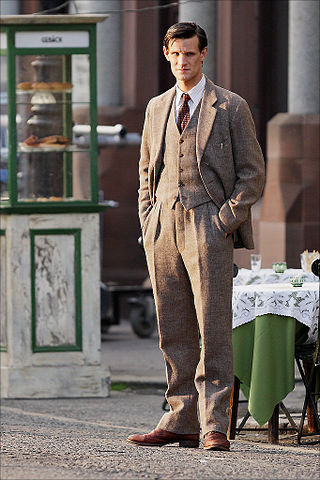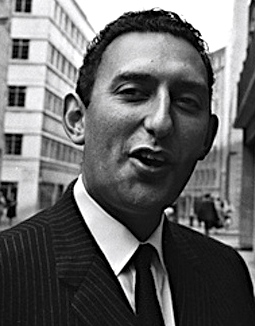
Yves Henri Donat Mathieu-Saint-Laurent, better known as Yves Saint Laurent or YSL, was a French fashion designer who, in 1962, founded his eponymous fashion label. He is regarded as being among the foremost fashion designers of the twentieth century.

A coat is typically an outer garment for the upper body, worn by any gender for warmth or fashion. Coats typically have long sleeves and are open down the front, and closing by means of buttons, zippers, hook-and-loop fasteners, toggles, a belt, or a combination of some of these. Other possible features include collars, shoulder straps, and hoods.

A suit, also called a lounge suit, business suit, dress suit, or formal suit is a set of clothes comprising a suit jacket and trousers of identical textiles generally worn with a collared dress shirt, necktie, and dress shoes. A skirt suit is similar, but with a matching skirt instead of trousers. It is currently considered semi-formal wear or business wear in contemporary Western dress codes, however when the suit was originally developed it was considered an informal or more casual option compared to the prevailing clothing standards of aristocrats and businessmen. The lounge suit originated in 19th-century Britain as sportswear and British country clothing, which is why it was seen as more casual than citywear at that time, with the roots of the suit coming from early modern Western Europe formal court or military clothes. After replacing the black frock coat in the early 20th century as regular daywear, a sober one-coloured suit became known as a lounge suit.

A tailor is a person who makes or alters clothing, particularly in men's clothing. The Oxford English Dictionary dates the term to the thirteenth century.

Savile Row is a street in Mayfair, central London. Known principally for its traditional bespoke tailoring for men, the street has had a varied history that has included accommodating the headquarters of the Royal Geographical Society at 1 Savile Row, where significant British explorations to Africa and the South Pole were planned; and more recently, the Apple office of the Beatles at 3 Savile Row, where the band's final live performance was held on the roof of the building.

Valentino Clemente Ludovico Garavani, known mononymously as Valentino, is an Italian fashion designer, the founder of the Valentino brand and company. His main lines include Valentino, Valentino Garavani, Valentino Roma, and R.E.D. Valentino.

Brioni is an Italian menswear luxury fashion house based in Rome and specialized in sartorial ready-to-wear, leather goods, shoes, eyewear and fragrance, and provides a tailor-made service (Bespoke).
Kiton is an Italian fashion house founded by Ciro Paone in Arzano, NA 1968.

Fashion in the years following World War II is characterized by the resurgence of haute couture after the austerity of the war years. Square shoulders and short skirts were replaced by the soft femininity of Christian Dior's "New Look" silhouette, with its sweeping longer skirts, fitted waist, and rounded shoulders, which in turn gave way to an unfitted, structural look in the later 1950s.

History of fashion design refers specifically to the development of the purpose and intention behind garments, shoes, accessories, and their design and construction. The modern industry, based around firms or fashion houses run by individual designers, started in the 19th century with Charles Frederick Worth who, beginning in 1858, was the first designer to have his label sewn into the garments he created.

The 1910s in Western fashion encompasses styles from 1910 to 1919. Western fashion in this period carries influences from oriental and neoclassical inspirations as well as the subsequent effects of World War I. Over the decade, Women's fashion experienced a shift towards shorter hemlines and dropped waistlines in addition to the more practical garments necessitated by the war. In men's fashion, evening wear largely continued to adhere to previous conventions while trends in informal outerwear continued to evolve. During the period, shifts in fashion made way for styles associated with the Jazz Age of the 1920s.
A man's suit of clothes, in the sense of a lounge, office, business, dinner or dress suit, is a set of garments which are crafted from the same cloth. This article discusses the history of the lounge suit, often called a business suit when featuring dark colors and a conservative cut.

H. Huntsman & Sons is a high-end fashion house and bespoke tailor located at No. 11 Savile Row, London. It is known for its English bespoke menswear tailoring, cashmere ready-to-wear collections, and leather accessories.

Timothy Charles Peto Everest is a Welsh tailor and fashion designer. He moved to London in his early twenties to work with the Savile Row tailor Tommy Nutter. He then became one of the leaders of the New Bespoke Movement, which brought designer attitudes to the traditional skills of Savile Row tailoring.

Savile Row tailoring is men and women's bespoke tailoring that takes place on Savile Row and neighbouring streets in Mayfair, Central London. In 1846, Henry Poole, credited as being the "Founder of Savile Row", opened an entrance to his tailoring premises at No. 32 Savile Row. The term bespoke is understood to have originated in Savile Row when cloth for a suit was said to "be spoken for" by individual customers. The short street has been termed the "golden mile of tailoring", where customers have included Charles III, Winston Churchill, Lord Nelson, Napoleon III, Muhammad Ali Jinnah, Laurence Olivier and Duke Ellington.

John Michael Ingram was an influential British menswear designer and retailer of the 1950s and '60s who founded the John Michael fashion brand, followed by a range of successful retail concepts, before establishing one of the first fashion forecasting agencies in the 1970s.

Henry Digby Morton (1906–1983) was an Irish fashion designer and among the leading names of British couture in the period from 1930-50. He was also among the pioneers of ready-to-wear fashions in the 1950s. Successful on both sides of the Atlantic, he redefined women's suits and tailoring, earned himself the moniker 'Daring Digby' for his US fashion venture and helped to establish the Incorporated Society of London Fashion Designers, an early forerunner of the British Fashion Council.

Isaia is a Neapolitan tailoring luxury brand founded by Enrico Isaia in Naples in 1920. The brand is recognized by its tiny red coral logo, which is a good-luck charm in Naples. The brand describes its clientele as "passionate, sophisticated, irreverent, eclectic and elegant."

A suit jacket, also called a lounge jacket, dress jacket, lounge coat or suit coat, is a jacket in classic menswear that is part of a suit.
Neapolitan tailoring was born as an attempt to loosen up the stiffness of English tailoring, which did not suit the Neapolitan lifestyle or climate.




















